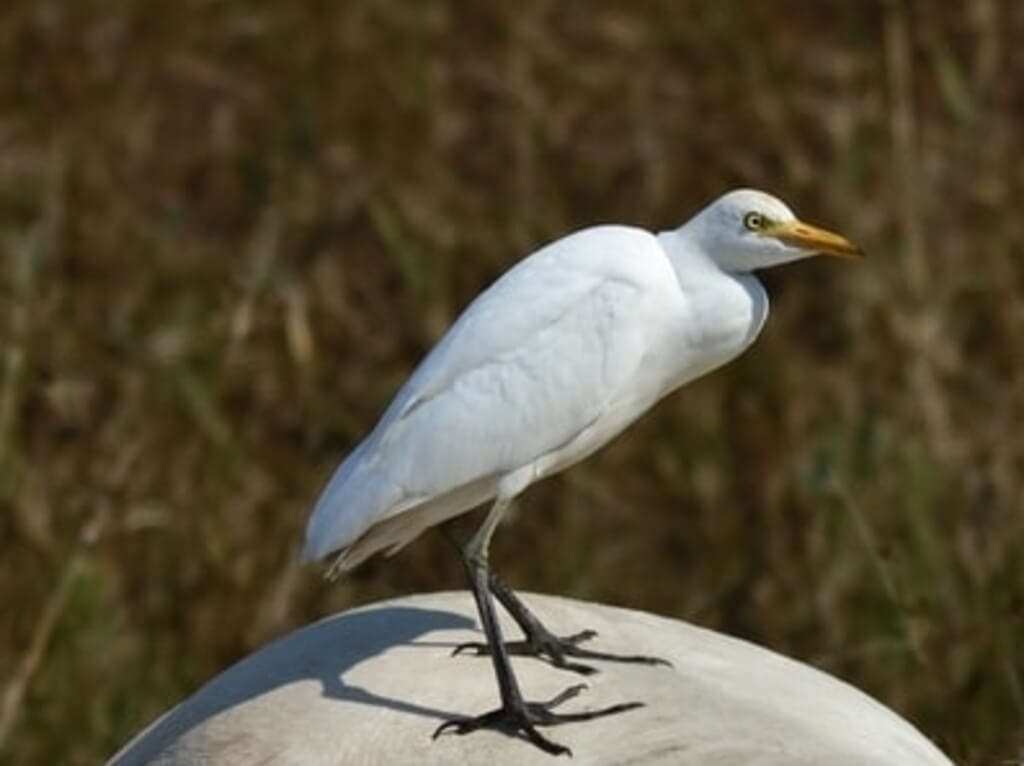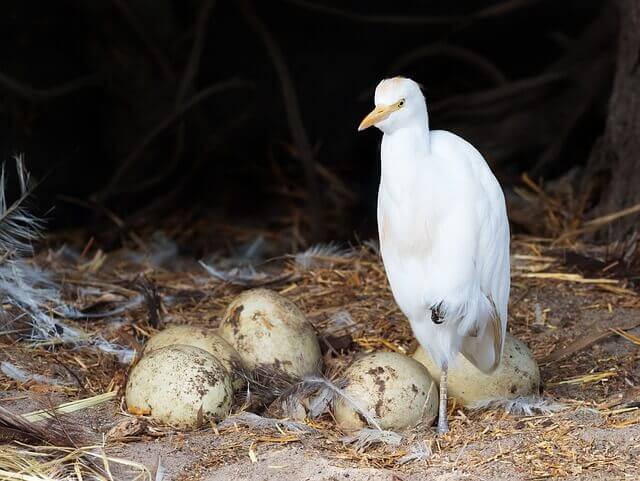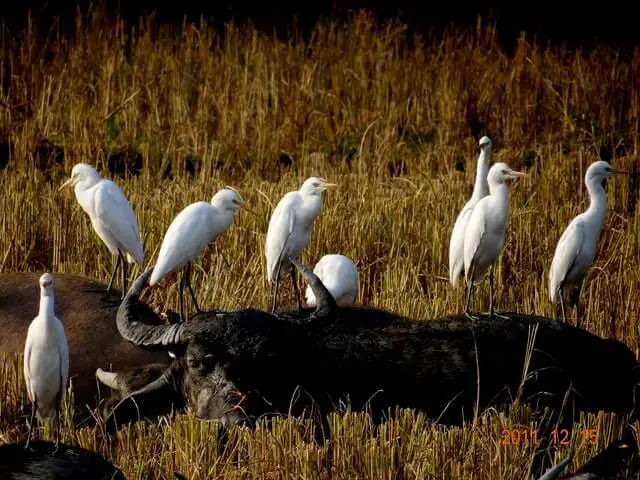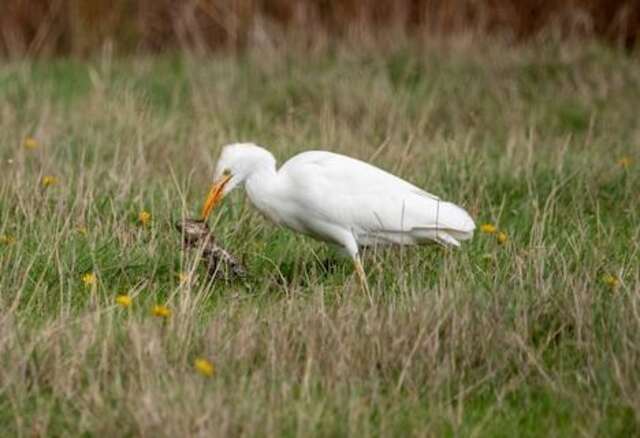Prepare to be amazed by the fascinating world of cattle egrets! These elegant birds, known for their unique behavior and adaptability, have a wealth of intriguing secrets to uncover.
In this captivating journey, we’ll dive deep into the lives of these feathered wonders as we present 55 fun facts about cattle egrets.
From their global distribution to their remarkable nesting habits, you’re about to embark on an adventure that will leave you with a newfound appreciation for these remarkable avian companions.”
Table of Contents
Cattle Egret (Overview)
Fun Facts About Cattle Egrets
| Characteristics | Description |
|---|---|
| Identification | Cattle Egrets are smaller herons, measuring about 18–23 inches tall with a three-foot wingspan. In their adult form, they have white plumage with a yellow bill, legs, and feet. During breeding, they develop rusty-colored plumes on the hindneck, breast, and back. Juveniles have white plumage with a dark bill, legs, and feet. |
| Adult Length | 1.5 – 1.9 feet (18.0-23.0 inches). |
| Adult Weight | 9.5 – 18.2 oz (270-515 g). |
| Wingspan | 2.9 – 3.2 feet (34.5-38.0 inches). |
| Taxonomy | Kingdom: Animalia, Phylum: Chordata, Class: Aves, Order: Pelecaniformes, Family: Ardeidae, Genus: Bubulcus, Species: B. ibis, Binomial Name: Bubulcus ibis, Scientific Name: Bubulcus ibis. |
| Distribution Range | Africa, Australia, New Zealand, Europe, Asia, North America, and South America. |
| Migration | Some populations are highly migratory, covering extensive distances of up to 5,000 miles each year. Migration patterns vary by region, with many heading to North Africa and Asia during winter. |
| Habitat | Coastal areas, swamps, wetlands, pastures, grasslands, and dry regions. |
| Diet | Mainly amphibians, reptiles, invertebrates (beetles), crustaceans (crayfish), and other fish. They also consume carrion when available. |
| Global Extent of Occurrence | 10,000,000 km2 (4,000,000 sq mi). |
| Population | Global Population: Estimated 3.7–6.8 million individuals; European Population: Estimated 185,000 individuals. |
| Conservation Status | Listed as Least Concern (Population Increasing). |
| Lifespan | In the Wild: 17 years of age; In Captivity: 23 years of age. |
| Breeding Period | April – Mid-September. |
| Incubation Duration | 22–28 days. |
| Nestling Duration | 14–21 days. |
| Clutch Size | 2–4 eggs. |
| Egg Color | Light Teal. |
| Nesting Habits | Cattle Egrets choose various locations like trees, bushes, reeds, or plants to build nests. They weave materials like grass, leaves, and twigs to construct the nest. The pair incubates 2–4 eggs for about 28 days until hatching. The female cares for the chicks for around 4 weeks until they fledge, typically about 4 weeks after hatching. |
- Cattle egrets typically nest in colonies around large trees or shrubs near water sources, often with other wading birds such as American white pelicans, great blue herons, gray herons, little blue herons, spoonbills and sometimes Florida scrub jays or American crows.
- Cattle egrets are somewhat migratory, but more of a year-round resident than other herons. The population is strongly tied to water bodies, meaning more of them can find food within their home territory.
- Once thought to be an example of convergent evolution with no vocalizations, there are recorded cases of cattle egrets communicating with each other via clicks. The clicks are produced when hunting for prey or defending their territory against trespassers.
- The wings of the cattle egret are long and narrow, and it has a relatively long neck.
- In flight, their necks are often tucked in, making them look shorter.
- Cattle egrets have a light rust-colored plume patch on the hindneck, which can be used to ruffle up their feathers for distraction display when defending nests from potential predators. In some cases the tip of this patch may be hidden from view when kept flat against the neck during normal preening activities, but will be raised if needed.
- Commonly seen often near North American cattle pastures.
- Both sexes help with nest building. Nests are made shallow, into a bowl shape, comprised of twigs, sticks, vines, and blades of grass.
- After about 28 days of incubation, they hatch and are fed by both parents with bugs, frogs, snakes, mice etc. They leave the nest after 10–15 days, and can fly after 25 days.
- Cattle Egrets are very social animals that live in clusters called colonies. They are usually not found individually, although individuals can be seen wandering around smaller groups of one to five birds.
- Cattle egrets are long-lived birds, with a mean life expectancy of 17 years in the wild and 23 years in captivity.
- The majority of Cattle Egrets do not migrate; they remain year-round in the same general area, unless there is bad weather or food shortages.
- They mate only once every year, staying together only until nesting season has finished.
- Cattle egrets usually feed by standing still in shallow water or tall grass while waiting for prey to come within reach.
- Occasionally, they may move slowly through vegetation while probing with their bill.
- Cattle Egrets are known for their habit to eat ticks from cattle and other livestock. The insects they consume from cattle will often carry diseases such as Lyme disease, which they transfer to other animals and humans through their droppings, feathers and feet.
- Cattle egrets are excellent flyers, and they are known to travel great distances during their seasonal migrations, often covering thousands of miles.
- While they primarily follow large mammals for food, cattle egrets are opportunistic feeders and will also catch insects in flight, such as butterflies and moths.
- These birds are skilled at adapting to changing environments and have been observed nesting in non-traditional habitats, including on man-made structures like cell towers and power poles.
- Cattle egrets have a diverse diet that can include a wide range of invertebrates, making them versatile and adaptable predators.
- The cattle egret’s call is a series of harsh, guttural croaks, which they use for communication within their colonies.
- They are known to engage in mutualistic relationships with herbivores, as they not only feed on insects disturbed by grazing animals but also act as “tickbirds” by removing ticks and other parasites from the bodies of large mammals.
- In some regions, they are considered sacred birds and are protected by local beliefs and customs.
- These birds are often associated with certain cultural myths and legends in some indigenous societies where they are found.
- They have been studied for their role in pest control in agricultural areas, as they help reduce insect populations that can harm crops.
- Cattle egrets have been introduced to some regions as a biological control measure to manage pests, although this has sometimes led to unintended consequences.
- In some cases, they have been known to nest alongside colonies of other bird species, forming mixed-species nesting sites.
- Cattle egrets are highly adaptable to human-altered landscapes and can be found in urban areas, golf courses, and industrial sites, in addition to more natural habitats.
Frequently Asked Questions
What do cattle egrets do for cattle
Cattle egrets have been known to help by eating parasites off the skin of cattle. This can be helpful to farmers because it helps keep their livestock healthy.
Do egrets sit on cows?
Egrets have been known to sit or stand on cows since ancient times, providing protection from bugs and other pests that would otherwise bother the cows.
Can you shoot cattle egrets?
Cattle egrets are a protected species under the Migratory Bird Treaty Act and cannot be shot in accordance with this law. Cattle egrets are classified as a migratory bird under the Migratory Bird Treaty Act of 1918, which means they cannot be shot or killed by anyone for any reason.
Why is it called a cattle egret?
The name cattle egret comes from its tendency to live near grazing livestock such as cattle, sheep, horses and buffalo herds.
Do cattle egrets eat grasshoppers?
Cattle egrets are often seen eating grasshoppers. Grasshoppers provide an important source of food for cattle egrets, especially during the breeding season, when they need more protein to feed their chicks.





